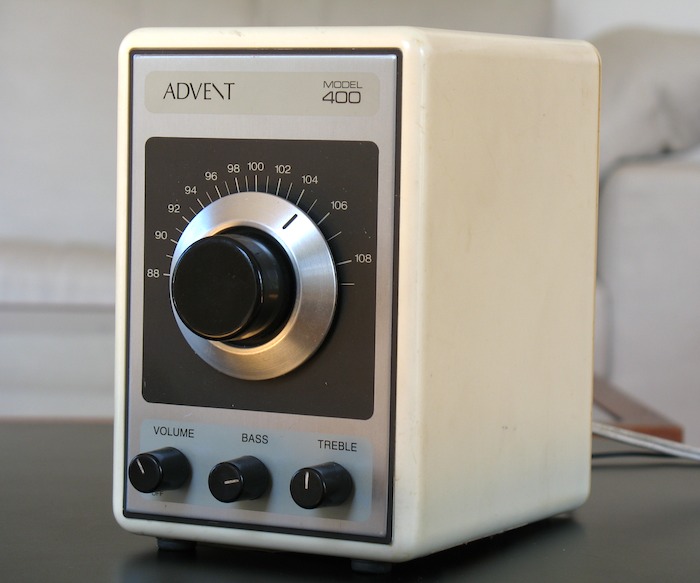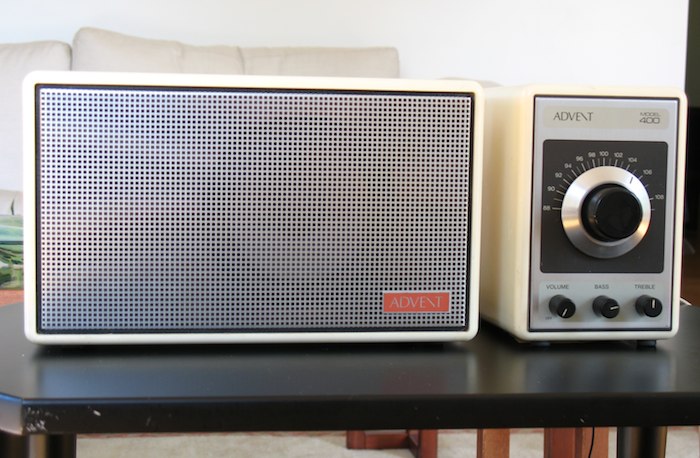
The Advent 400 was another of the great radios designed by Henry Kloss. It was the radio I used in college in the mid-1970s. The tuner is quite sensitive. A 30" length of wire was often enough for good reception. In my dorm room, hooking it up to a simple folded dipole made it possible to receive stations from 125 miles away and more. (Hint: if you do this, hook up only one of the dipole leads to the radio. It seems to work better than connecting both of the leads!)
The dial is also a signature Kloss design. There's a small amount of lubricant in the tuner shaft, enabling the inner knob to turn multiple times for each turn of the outer dial. No dial cords! (I have always hated dial cords.) Earlier KLH radios and later Tivoli radios use much the same principle.
The back of the radio has some basic pre-amp style capabilities. You can feed an external source into the radio's amplifier for listening through the speaker. And there was a tuner output, most useful for recording.
It's mono only; no stereo. Still, the radio could sound big for its size. My fellow dorm residents would drop by and ask, "where's the other speaker?"
In 1980, the radio died. Fortunately, I was able to contact the factory, send it off, and get it repaired and overhauled. That was just before Advent encountered financial difficulties and ended up being sold to some conglomerate. Advent had been especially noted for its speakers, though it also made an interesting stereo tuner, the Model 300. By the mid-1980s, all of those great products were no longer made.
The cabinet was originally pure white. It has yellowed over the years. This seems to be inherent; almost all eBay listings that I've seen for 400s indicate some yellowing.
It still is a wonderfully naturally sounding radio. The speaker lacks deep bass; it starts rolling off about 100 Hz. But I am not a fan of big, boomy bass anyway. The radio sounds especially good on stations with a lot of talk programming, such as just about any National Public Radio station.
In the 1970s, the FM dial was less crowded, so sensitivity could triumph over selectivity. The radio was relatively free of front-end overload, though a strong signal could overwhelm the ability to pick up stations nearby on the dial. Nowadays, the Advent 400's tuner seems less selective than it should be. Perhaps the tuner is a bit out of alignment, and it is now fussy to tune because the tuning condenser needs cleaning. But, whenever I get it out and listen to it, I'm still amazed at how pleasant it sounds.

After writing this review, I obtained a brochure published by the Advent Corporation in January 1976, featuring reviews of the Advent 400 radio.
Reviews were published from two of the leading hi-fi magazines of the day, High Fidelity and Audio, as well as articles from Popular Science and the Toronto FM Guide.
Most interesting to me was the review in Audio by the late Leonard Feldman, who did so many tuner and receiver reviews over the years. Feldman wrote of the radio, "though we started out to do a 'quick test' of its performance, we soon discovered that it merited the full lab treatment we normally accord full-fledged, high-fidelity component receivers."
It often seemed to me at the time that Mr. Feldman never met a tuner he didn't like. I think the reality was a little more complex, though. Tuners, FM tuners particularly, really had been getting better over time, well into the 1990s. Then progress seemed to stop. DSP-based radios represent a new front for advancement, but their sound quality still doesn't quite match the best of the hi-fi tuners that Mr. Feldman and his competitors reviewed.
Mr. Feldman was always thorough in his reviews, and it showed for the Advent 400. (His was the only one of the four reviews that published a full set of tuner measurements.) He found, for example, that usable sensitivity for the radio was 2.9 microvolts, or 14.64 dBf (a measurement just coming into effect) over a 300 ohm input. That's not the most sensitive tuner there was, then or now, but it's still very good. His testing also indicated that the sound quality coming from the tuner was among the best he had measured, as indicated by distortion figures. As he put it, "once tuned in properly, sound is clean and quite unlike you have ever heard from a 'table model' radio."
One of the other reviewers quoted in this set of clippings felt the radio was quite selective and, based on conditions prevailing in 1975 and 1976, it would have been, in most areas. The dial has become much more crowded since, and selectivity sometimes can be a problem with this radio under modern conditions. Regardless, the radio still sounds great after more than 35 years.